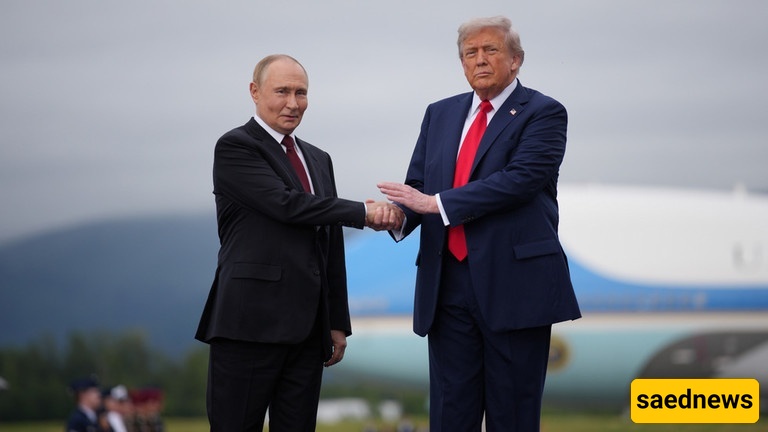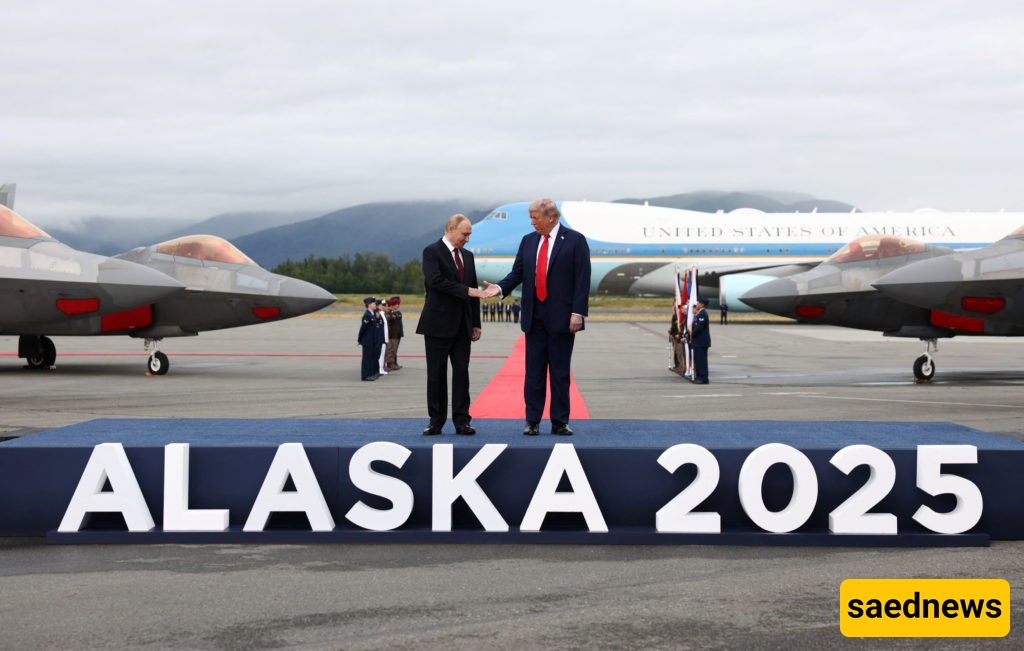SAEDNEWS: Donald Trump described the meeting with Vladimir Putin in Alaska as “warm” and “infinitely friendly,” speaking enthusiastically about the mutual understanding between the two sides. But behind the smiles and flashy symbols, no agreement was reached to end the war in Ukraine—or even a simple ceasefire.

According to SaedNews, citing Russia Today, the highly publicized meeting between Donald Trump and Vladimir Putin in Alaska, which marked the Russian president’s first presence on U.S. soil since the start of the Ukraine war, resembled more a flashy political show than a decisive negotiation. At the end of the meeting, Trump spoke passionately of a “warm session” and, in a television interview, described Putin as “a powerful man, tough but very warm.” Yet when the curtains were drawn and the smiles faded, the reality became clear: no agreement had been reached to end the war in Ukraine, nor even for a temporary ceasefire. The contrast between the warmth of words and the coldness of results turned this meeting into a fresh stage for criticism of Trump’s foreign policy.

The grand reception for Putin—from the red carpet to the two leaders riding together in the presidential limousine dubbed the “Beast”—was meant to signal goodwill and the start of a new chapter in relations between the two countries. But this theatrical aspect, given the lack of any tangible achievements, drew criticism from many analysts. For Trump’s opponents, the meeting highlighted a style where symbols outweighed substance, rather than demonstrating effective diplomacy. They warned that such behavior could unintentionally legitimize Putin, while Russia continues its military operations in Ukraine.
Putin, however, made the most of the opportunity. Not only did he appear before reporters before Trump and convey his message to the media, but he also managed to be seen as a legitimate leader on U.S. soil. For domestic Russian public opinion, Putin’s presence in Alaska and Trump’s warm reception represented a propaganda victory, signaling that the Kremlin still maintains its standing on the global stage. Russian media immediately reinforced this narrative, presenting it as a diplomatic triumph.
Trump, on the other hand, tried to turn the meeting into part of his domestic narrative—a portrayal of himself as a powerful dealmaker capable of turning personal relationships into diplomatic tools. In an interview with Fox News, he emphasized friendliness and “mutual understanding” and spoke of his personal friendship with Putin. This type of discourse had been observed previously during his first presidency and was once again used as part of his political brand. But the crucial question remains: is the American public, especially amid a bloody war in Europe, willing to trust this kind of “warm diplomacy”?
The Democrats have a clear answer: no. Party leaders, in statements and multiple interviews, described the Alaska meeting as a sign of Trump’s weakness and his inclination to appease the Kremlin. In their view, such displays not only fail to advance peace but could strengthen Russia’s bargaining power and increase pressure on Ukraine. They also warned that this behavior could deepen the rift between the U.S. and its European allies, as Europe is more concerned than ever about the cohesion of the Western front against Moscow.
The reality is that Europe’s reaction was also a mix of concern and disappointment. In Brussels, European Union officials, while cautiously welcoming any effort at negotiation, reminded that without a halt to Russian attacks in Ukraine, no political dialogue could be considered legitimate. In Berlin and Paris, analysts also emphasized that Trump, by focusing excessively on the spectacle, risked undermining Western cohesion. Although some governments supported the principle of dialogue, all stressed that a “real ceasefire” would be the only measure of success.
In Kyiv, reactions were harsher. Ukrainian officials expressed disappointment and called the meeting a “missed opportunity.” Volodymyr Zelensky, in remarks, stressed that any negotiation must revolve around an immediate halt to Russian attacks, adding: “Warm words do not save lives.” Public opinion in Ukraine largely viewed the Alaska meeting more as an attempt to sanitize Putin’s image than a genuine effort to end the war.
Inside the United States, the meeting had varying political implications. Trump-supporting Republicans saw it as evidence of his ability to establish personal relationships with world leaders and presented it as a strength for foreign policy. They argued that such personal ties could pave the way for future agreements. However, critics, particularly in mainstream media, emphasized the lack of tangible achievements and described the meeting as an example of “performative diplomacy.” This duality once again revealed the deep domestic political divide in the U.S. over the approach to Russia.
Beyond the reactions, a fundamental question remains: could this meeting serve as a prelude to more serious negotiations, or will it be remembered in the media only as a fruitless spectacle? Some optimistic analysts believe that even if no immediate results were achieved, establishing channels of communication between the two major powers could lay the groundwork for tension reduction in the future. In their view, sometimes the first step is simply breaking the ice in relations. But pessimists warn that in the absence of genuine will for change on the battlefield, any meeting only strengthens Russia’s position and puts Ukraine in an even more difficult situation.
From a strategic perspective, the Alaska meeting displayed a clear contrast between form and substance. The form included smiles, handshakes, and warm words; the substance, however, was the lack of agreement and the continuation of the war. This contrast could have long-term implications for U.S. foreign policy. If this pattern continues, the United States could increasingly become a stage for symbolic politics—policies where spectacle replaces results.
Ultimately, what happened in Alaska can be remembered as a classic example of the gap between performative diplomacy and real diplomacy in history. Trump described the meeting as “warm,” but the “cold” reality of no agreement remains. For him, this encounter may serve as a suitable political tool domestically, but internationally, it sent only one message: the world must still wait to see whether the U.S. and Russia can go beyond smiles and souvenir photos to find a way to end one of the bloodiest crises of the twenty-first century.

